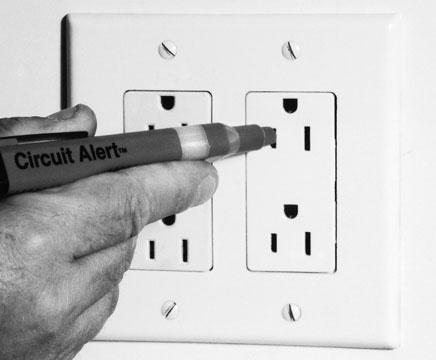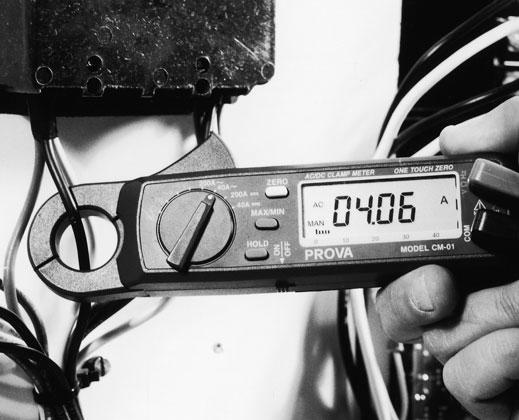
7 minute read
Checking Voltage, Continuity, and Polarity on AC Circuits
To test a GFCI, simply depress the test button on the assembly faceplate. This trips the internal breaker and actually exercises the outlet’s inner workings to ensure that it’s functioning as it should. If the test and reset buttons feel spongy and seem to have lost their crisp snap action, odds are good that the GFCI mechanism is corroded, and the outlet should be replaced.
Another point worth mentioning here is that just because the dock box that your boat is connected to at the marina is protected by GFCI (and it always should be), you shouldn’t think that you’re protected from shock hazard on your boat. These dockside GFCIs are likely to be forgotten by the maintenance crew and never tested until it’s too late. To be safe, always test the dockside outlets before you plug in your shore-power cord, and to eliminate any worry, upgrade your boat with this important protection as soon as you can.
Advertisement
Sooner or later, problems will crop up with the AC circuits on your boat, and you’ll need to do basic multimeter tests for voltage, polarity, and continuity. There is no need to be afraid of doing these tests on AC circuits, even for the novice, but following some basic rules, in addition to the safety rules listed above, will ensure that you won’t damage your meter or end up having a shocking experience.
Besides your multimeter, several small, inexpensive testers can be extremely useful when working around AC systems. Figure 11-9shows an LED outlet tester with a built-in GFCI test function, and figure 11-10 shows an inductive voltage sensor used for verifying the presence of AC voltage, even behind panels and through insulation. The LED outlet tester is useful in determining whether reverse polarity exists and whether or not there is an open circuit in any of the three conductors.
It is not at all uncommon for low voltage to be a problem in an AC circuit, or reverse polarity for that matter. A disconnected green grounding conductor is quite common and can go unnoticed until someone gets a shocking jolt. The good news here is that these problems usually originate at the dock, not on the boat, and it’s easy to check for them yourself.
Figure 11-10demonstrates using the inductive AC tester to see if there is voltage present at an outlet. If the tester’s LED flashes and it emits a steady beeping noise, AC is present in the circuit. The only remaining question is how much voltage. To determine that, you’ll need your multimeter.
Fig. 11-9. An LED outlet tester.
Fig. 11-10. Using the inductive AC tester to check voltage at an outlet.

Checking AC Voltage
When using your multimeter to check for AC volts, you need to remember that AC and DC volts are different as far as your meter is concerned. With either volts or amps, you must switch to the AC function on your meter before making any checks. If your meter is self-scaling (auto-ranging), the next step is to simply insert the leads into the appropriate sockets and take a direct reading on the meter, as shown in figure 11-11.
Note that in the diagram the meter’s red lead is inserted into the smaller of the two slotted holes and the meter’s black lead is inserted into the larger. Don’t forget to turn on the appropriate branch breaker before making this test. If your meter is not self-scaling, make sure you select the appropriate scale for the voltage you’re expecting to read.
When verifying voltage at an appliance, a hotwater heater for example, that’s hard-wired into the circuit (permanently installed rather than plugged into an outlet), you’ll need to get at the terminals in the junction box on the appliance. With the branch breaker for the appliance turned on, check for proper voltage at the appliance by touching your red meter probe to the terminal on the black AC wire and the black meter probe to the terminal on the white AC wire. Simply take a direct reading. In figure 11-12,the AC voltage supply to a typical marine hot-water heater is being verified.
A useful tip to help you when working with AC circuit testing is to get two short lengths of heatshrink tubing at your local supply house, one white and the other black. Shrink the black piece around the red lead on your multimeter and the white piece around the black lead. This will remind you that the black lead on the AC is the positive and the black lead is the neutral when working with AC. It simply gives you a quick color reference to work with.
Slight variations in your meter readings are the norm when measuring AC voltage. In fact, a variation of as much as plus or minus 10 percent of the rated voltage is possible. If your dockmates are all using the AC system feeding the marina simultaneously, you can expect a lower voltage reading.
At peak usage times of the day (usually around breakfast and dinner) you can also expect lower readings. AC generators on board could also conceivably run to that much of a variation. This variation is not indicative of any particular problem
Black
Red

Fig. 11-11. Using a multimeter to check voltage at an outlet. Fig. 11-12. Using the multimeter to check voltage to a hotwater heater terminal block.
and will not affect the performance of your onboard equipment as long as the 10 percent variation at the rated frequency (either 50 or 60 Hz) is not exceeded. By the way, multimeters that can read frequency have dropped considerably in price and are available for less than $50. If you’re going to work with AC regularly, this is a good added feature to have on your meter. Checking AC Amperage
Checking AC amperage through a circuit can be a bit tricky. The problem is that since sheathing protects AC wiring through most of its length, it’s sometimes tough to find a single conductor around which to clamp your meter to take a reading. Remember that with an inductive clamp-type ammeter you can only use one conductor to measure amperage. This applies to both AC and DC. The truth is, this is not a reading you’ll be making very often, because AC appliances all provide the data needed to determine amperage. The need to actually measure amperage in AC systems is far less of an issue than it is with DC circuitry. Figure 11-13shows an inductive AC clamp meter being used to determine current in an AC circuit.
AC Continuity Tests
Continuity tests for AC circuits are more frequently needed than are voltage and amperage tests, and the ability to perform a good continuity test will be useful, especially when checking things like shorepower cords.
The most important point to remember when checking for continuity is to be certain the wiring that you intend to check is disconnected from the power source. The risk here goes beyond simply damaging your multimeter; it’s also a shock hazard. Continuity tests can be used not only to determine the integrity of wiring, but also to check some resistive AC appliances—things such as a hot-water heater element or an electric coffee maker.
The Ed Sherman Wiggle Test
When checking the conductor continuity in any flexible cord, such as a shore-power cord, it’s a good idea to perform what I call the wiggle test.
These cords take quite a beating and are frequently abused. It’s quite possible to get a solid continuity reading with your meter and lose continuity when the cord is flexed, especially close to the ends where the cord’s three conductors attach to the plug ends. Figure 11-14on page 170 shows a typical shorepower cord being wiggle-tested.
To do the Sherman wiggle, set your meter to the ohms scale and connect one meter probe to the prong on the plug and the other probe to the corresponding socket at the other end of the cable. You should get a very low ohms reading, near zero if all is well. Next, bend and flex (i.e., wiggle) the plug and socket ends while firmly holding the cable. Carefully observe your meter, and look for a change from a low ohms reading to an open-circuit reading of infinity, or “OL” on digital meters.
A fluctuating reading indicates a break in continuity behind the insulation at the plug end. Check all three conductors in this way to be sure they’re all OK. If any momentary break in continuity is indicated, a suitable replacement end will need to be installed on the cord. Marinco, an electric supply company, makes quality replacement plugs and sockets that are available at all good marine supply houses.

Fig. 11-13. An inductive-current clamp used to check current on an AC appliance.




